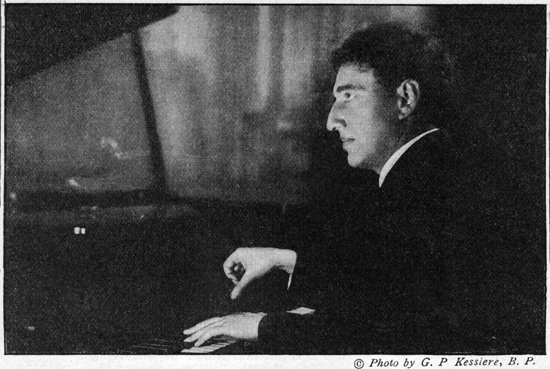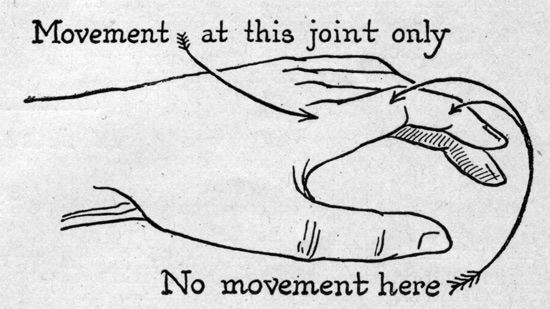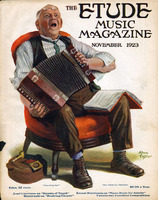Basic Principles in Pianoforte Playing
Secured Exclusively for The Etude by Interview with the Famous Virtuoso Pianist
JOSEF LHÉVINNE
This Series Began in the “Etude” for October

“IN our first discussion of this subject we dwelt at considerable length upon the fact that before the student even considers the matters of technic and touch, a good grounding in real musicianship is necessary. I cannot leave this phase of the matter without pointing out that a knowledge of the keys, the common chords, and the seventh chords, should be as familiar to the student as his own name. This would not be mentioned were it not for the fact that I have repeatedly had students come for instruction who have after great effort prepared one, two, or at the most three show pieces, even pieces as far advanced as the Tschaikowsky or the Liszt Concerto, who barely knew what key they were playing in. As for understanding the modulations and their bearing upon the interpretations of such complicated and difficult master works, they have been blissfully ignorant.
“Study of this kind is not only a great waste of the pupil’s time but also a disgusting waste of the time of the advanced teacher, who realizes that he is not training a real musician but a kind of musical parrot whose playing must always be meaningless. Often these pupils have real talent and cannot be blamed. They simply have had no teacher in the early years with patience and sufficient will power to hold them back until they have been exhaustively drilled in scales and arpeggios. A smattering will not do. They must know all the scales in all the keys, major and minor, and they must literally ‘know them backwards.’ They must know the interrelationship of the scales; for instance, why G# minor bears a harmonic relationship to c-flat major.
Instinctive Fingering
“The scales should be known so well that the student’s fingers will fly to the right fingering of any part of any scale instinctively. The trouble with many students is that they attempt difficult problems in what might be termed musical calculus or musical trigonometry without even ever mastering the multiplication table. Scales are musical multiplication tables. One good way of fixing them in the mind is to start to play the scales upon the different tones of the key consecutively.
“Take the scale of E major, for instance. Play it first this way, starting with the keynote.

“Next start with the second note of the scale with the second finger, thus:
 “Then with the third finger, thus :
“Then with the third finger, thus :

“Then with the fourth note with the thumb, thus :

“Continue throughout the whole scale; and then play them in similar manner with the right and the left hand together. Treat all the scales in the same manner.
“Most pupils look upon scales as a kind of musical gymnasium for developing the muscles. They do that, of course, and there are few technical exercises that are as good; but their great practical value is for training the hand in fingering so that the best fingering in any key becomes automatic. In this way they save an enormous amount of time in later years. They also greatly facilitate sight reading, because the hand seems to lean instinctively to the most logical fingering, to elect it without thinking. Take it for granted, you may have too little scale practice, but you can never have too much.
“The study of harmony is also a great time saver in piano playing. Know the chords and know the fingering of all the arpeggios, which is really logical fingering of most of the common chords. Don’t pay a teacher a high fee later in your musical life to have him point out something that you should have learned in the musical primary class.
The Value of Ear Training
“Ear training is also of very great importance. Most students hear, but they do not listen. The finest students are those who have learned how to listen. This becomes an axiom with teachers of advanced pupils. The sense of aural harmony cannot be too definitely developed. The pupil who cannot identify chords, such as the common chords, and the seventh chords, by ear, stands about as much chance of entering the higher realms of music as the student who does not understand a word of Latin does of comprehending a page from Virgil when he hears it read to him.
“There is no way of dodging or sidestepping this knowledge. I am obliged to say a hundred times a week, ‘Listen to what you are playing.’
“Absolute pitch is by no means absolutely necessary. I have it and have always had it. Safonoff, my own master, did not. Rubinstein did. Sometimes it is a disadvantage. I cannot think of any composition except in the key in which it was written. Sometimes when a piano is a whole tone flat or a half tone sharp, I become fearfully confused, as it does not seem that I am playing the right notes. I instinctively start to transpose the sounds to where they belong and thus get mixed up.
Essentials of a Good Touch
“The matter of touch is so all-important that the remainder of this section will be devoted to the subject. Even then, we cannot hope to cover more than a fraction of the things that might be said. Have not whole books been written upon the subject? Indeed, there is now in the different languages of the musical world, what might be called a literature of touch.
‘First of all, let us consider our playing members, the fingers, the hand, with its hinge at the wrist to the arm, and finally the torso—all of which enter into the problem of touch. With me, touch is a matter of elimination of nonessentials, so that the greatest artistic ends may be achieved with the simplest means. This is a general principle that runs through all the arts. Thus, in the manipulation of the fingers on the keys, I direct my pupils to cut out any action upon the part of the fingers except at the metacarpal points.
“The metacarpal joints are the ones that connect the fingers to the hands. Of course there are exceptions, when the other joints of the fingers come into play. These we shall discuss later; but for the main part we shall progress far more rapidly if we will learn the great general principle of moving the fingers only at the joint where the finger is connected with the body of the hand. There was a time, I am told, when the great aim of the piano teacher was to insist that the hand be held as stiff and hard as a rock while the fingers rose to this position, in which all of the smaller joints were bent or crooked, and then the finger descended upon the key like a little sledge hammer. The effect was about as musical as though the pianist were pounding upon cobble stones. There was no elasticity, no richness of tone, nothing to contribute to the beauty of tone color of which the fine modern piano is so susceptible. Now, the finger arises in this position and the movement up and down is solely at the point marked :

“Before proceeding farther we have to admit that touch is largely an individual matter and that the nature of the player’s hand has a great deal more to do with it than most people imagine. In days gone by there was an impression that a long, bony; fleshless hand, with hard finger-tips, was a good pianistic hand. It may be for execution of florid passages and great velocity; but for the production of a good tone it can be extremely bad.
“Rubinstein had a fat, pudgy hand, with fingers so broad at the finger-tips that he often had difficulty in not striking two notes at one time. Indeed, as I have pointed out hitherto, many of the so-called mistakes that he made were due to this condition. On the other hand, his glorious tone was in no small measure due to this. Indeed, it may be said that the thicker the cushions of flesh upon the finger-tips, the wider the range of variety of touch. Rubinstein, by means of an unearthly amount of work at the keyboard, was able to overcome technical obstacles and get the benefit of the responsive cushion he had at the ends of his fingers. This is merely a mechanical and acoustical principle. It is easy to distinguish when one listens to a metal xylophone. If the bars of the xylophone are struck with a hard metal rod, the tone is harsh and ‘metallic.’ Let them be struck with a rod with the end covered with soft felt and the tone is entirely different and beautifully musical. You may not think this applies to the tone of the pianoforte; but a little experimenting will soon show that it is the case.
Amateurs with Naturally Fine Touch
“It thus happens that many amateurs, who know little about music itself, possess a touch which is very beautiful merely because they have accidentally learned how to play with right arm conditions and with the proper part of their finger-tips; so that, instead of delivering a bony blow to the ivory surface, they touch the keys with felt-like cushions of human flesh and produce a really lovely tone without knowing how they do it. With proper instruction along these lines, I shall hope to make clear in ensuing sections of this series that it is possible for the person with an inferior touch to develop his tone amazingly.
“Of course, a brittle touch is quite as necessary at times as the mellifluous singing tone. Brilliancy is as important as ‘bel canto’ in piano playing. One general principle, however, is that of striking ‘key bottom.’ Many students do not learn this. The piano key must go all the way down in the production of a good tone. The habit of striking it half way accounts for much white or colorless playing. Many students do this without knowing it. It is a habit that quickly grows upon one. More than this, it contributes a kind of hesitancy and lack of sureness to playing that is decidedly inartistic. The player never seems sure of himself.
“During your next few practice periods, analyze your own playing and note carefully whether you are skimming over the surface of the keys. Unless you have had a very thorough early training, you will probably discover that one note in every ten is slighted. It may be just enough to give your whole playing an amateurish complexion. If you find that this is the case, return to the practice of slow scales and then slow, simple pieces with good melodies, and simple chords. Scores of students play chords with some of the notes striking key bottom and others only half way down. The full effect of the harmony is thus lost. Of course, you may not suspect that you do this; but do you really know?
“In the next section of this article we shall continue this discussion of beautiful tone-color, revealing what seems to be the real secret of a lovely singing tone. It is really quite a simple matter when the underlying principle is correctly understood. Of course, if the student has the privilege of studying it under a good teacher, it may be more rapidly acquired; but there is no reason why the main essentials cannot be told in print.”



